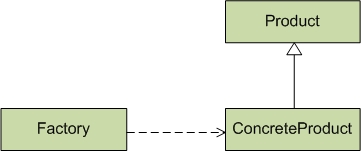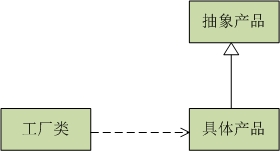 Java
Java
 javaTutorial
javaTutorial
 Taking Java code as an example to explain the simple factory pattern in design patterns
Taking Java code as an example to explain the simple factory pattern in design patterns
Taking Java code as an example to explain the simple factory pattern in design patterns
Simply put, the factory pattern is to return a type of object according to the requirements. The meaning of using the factory pattern is that if the instantiation of the object and the code dependency are too large, it will be inconvenient to expand and maintain. The purpose of using the factory is Decouple the instantiation of the object from the main program code. Let’s take a closer look:
1. Introduction to the Simple Factory Pattern
Simple Factory Pattern (Simple Factory), also known as the "static factory method pattern ". It belongs to the "creation pattern" (the pattern of creating objects) and is a special implementation of the "factory method" pattern.
Usually, we use the simple factory pattern to create classes. For example, obtaining a thread pool object is achieved through the simple factory pattern. Its structure diagram is as follows:

Factory: The factory is the core of the simple factory pattern and provides an external interface. If the client or other program wants to obtain the Product object, it must obtain it through the Factory interface.
Abstract products: Abstract products are abstractions of (many) different products. Product can be an interface or abstract class.
Concrete product: The product object returned in the factory is actually created through ConcreteProduct.
2. Simple factory pattern code model
public class Factory {
public static Product newInstance() {
return new ConcreteProduct();
}
}
public abstract Product {
}
public class ConcreteProduct extends Product {
public ConcreteProduct() {}
}
3. Practical application of simple factory pattern
We are writing a Servlet to process customers When making requests from the client, one Servlet often handles multiple business logics, such as:
protected void doPost(HttpServletRequest request, HttpServletResponse response) {
String flag = request.getParameter("flag");
if(flag.equals("service1")) {
service1();
}else if(flag.equals("service2")) {
service2();
}
...
}The above is the conventional method for our Servlet to handle multiple business logics, writing an if else statement. A better way is to separate the distribution of requests from the Servlet and let the Servlet only handle business logic. We regard various requested Servlets as product classes, javax.servlet.HttpServlet is the product parent class, and javax.servlet.Servlet is the product interface. In this way, we define a ServletFactory, parse the url request in the filter and hand it over to the ServletFactory for processing. That's it. This is a typical simple factory application.
@WebFilter("/TransRequest")
public class TransRequest implements Filter{
private String servletName;
@Override
public void doFilter(ServletRequest request, ServletResponse response,
FilterChain chain) throws IOException, ServletException {
HttpServletRequest myRequest = (HttpServletRequest)request;
//拿到请求的servlet名字, 这里我们约定请求都是/servletName形式
String names[] = myRequest.getRequestURI().trim().split("/");
servletName = names[2];
if( servletName != null) {
//以下是最典型的两句简单工厂的例子
Servlet servlet = ServletFactory.createServlet(servletName);
servlet.service(request, response);
}else
chain.doFilter(request, response);
}Every time a request comes, we use the factory to produce a servlet. This can be more convenient without configuring a large amount of servlet path information in xml. And this will also make the logic clearer. The servlet only handles business at the business layer.
The factory class is as follows:
public class ServletFactory {
public static Servlet createServlet(String servletName) throws ServletException {
if(servletName.equals("servletName1")) {
return new Service1();
}else if(servletName.equals("servletName2")){
return new Service2();
}else{
throw new ServletException("No such servlet");
}
}
}Although the above factory class does not abandon the cumbersome if else, it still solves some problems by using the idea of a simple factory. Simple factory is a very simple design pattern that is not considered a design pattern, and the problems it solves are also very limited. The above request distribution has been implemented in all major javaEE frameworks, such as Struts2. Of course, the framework is not a simple factory.
4. Summary
The simple factory pattern, in summary, is a factory class, a product interface (in fact, it can also be an abstract class, or even an ordinary parent class) and a group of products that implement The specific product of the interface, and this factory class, creates a specific implementation class based on the parameters passed in, and transforms it up to the interface as a result and returns it.
The above is using Java code as an example to explain the content of the simple factory pattern in the design pattern. For more related content, please pay attention to the PHP Chinese website (www.php.cn)!

Hot AI Tools

Undresser.AI Undress
AI-powered app for creating realistic nude photos

AI Clothes Remover
Online AI tool for removing clothes from photos.

Undress AI Tool
Undress images for free

Clothoff.io
AI clothes remover

Video Face Swap
Swap faces in any video effortlessly with our completely free AI face swap tool!

Hot Article

Hot Tools

Notepad++7.3.1
Easy-to-use and free code editor

SublimeText3 Chinese version
Chinese version, very easy to use

Zend Studio 13.0.1
Powerful PHP integrated development environment

Dreamweaver CS6
Visual web development tools

SublimeText3 Mac version
God-level code editing software (SublimeText3)

Hot Topics
 1389
1389
 52
52
 Perfect Number in Java
Aug 30, 2024 pm 04:28 PM
Perfect Number in Java
Aug 30, 2024 pm 04:28 PM
Guide to Perfect Number in Java. Here we discuss the Definition, How to check Perfect number in Java?, examples with code implementation.
 Weka in Java
Aug 30, 2024 pm 04:28 PM
Weka in Java
Aug 30, 2024 pm 04:28 PM
Guide to Weka in Java. Here we discuss the Introduction, how to use weka java, the type of platform, and advantages with examples.
 Smith Number in Java
Aug 30, 2024 pm 04:28 PM
Smith Number in Java
Aug 30, 2024 pm 04:28 PM
Guide to Smith Number in Java. Here we discuss the Definition, How to check smith number in Java? example with code implementation.
 Java Spring Interview Questions
Aug 30, 2024 pm 04:29 PM
Java Spring Interview Questions
Aug 30, 2024 pm 04:29 PM
In this article, we have kept the most asked Java Spring Interview Questions with their detailed answers. So that you can crack the interview.
 Break or return from Java 8 stream forEach?
Feb 07, 2025 pm 12:09 PM
Break or return from Java 8 stream forEach?
Feb 07, 2025 pm 12:09 PM
Java 8 introduces the Stream API, providing a powerful and expressive way to process data collections. However, a common question when using Stream is: How to break or return from a forEach operation? Traditional loops allow for early interruption or return, but Stream's forEach method does not directly support this method. This article will explain the reasons and explore alternative methods for implementing premature termination in Stream processing systems. Further reading: Java Stream API improvements Understand Stream forEach The forEach method is a terminal operation that performs one operation on each element in the Stream. Its design intention is
 TimeStamp to Date in Java
Aug 30, 2024 pm 04:28 PM
TimeStamp to Date in Java
Aug 30, 2024 pm 04:28 PM
Guide to TimeStamp to Date in Java. Here we also discuss the introduction and how to convert timestamp to date in java along with examples.
 Java Program to Find the Volume of Capsule
Feb 07, 2025 am 11:37 AM
Java Program to Find the Volume of Capsule
Feb 07, 2025 am 11:37 AM
Capsules are three-dimensional geometric figures, composed of a cylinder and a hemisphere at both ends. The volume of the capsule can be calculated by adding the volume of the cylinder and the volume of the hemisphere at both ends. This tutorial will discuss how to calculate the volume of a given capsule in Java using different methods. Capsule volume formula The formula for capsule volume is as follows: Capsule volume = Cylindrical volume Volume Two hemisphere volume in, r: The radius of the hemisphere. h: The height of the cylinder (excluding the hemisphere). Example 1 enter Radius = 5 units Height = 10 units Output Volume = 1570.8 cubic units explain Calculate volume using formula: Volume = π × r2 × h (4
 Create the Future: Java Programming for Absolute Beginners
Oct 13, 2024 pm 01:32 PM
Create the Future: Java Programming for Absolute Beginners
Oct 13, 2024 pm 01:32 PM
Java is a popular programming language that can be learned by both beginners and experienced developers. This tutorial starts with basic concepts and progresses through advanced topics. After installing the Java Development Kit, you can practice programming by creating a simple "Hello, World!" program. After you understand the code, use the command prompt to compile and run the program, and "Hello, World!" will be output on the console. Learning Java starts your programming journey, and as your mastery deepens, you can create more complex applications.



